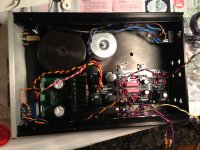Yes at first, too bright and harsh. Nasty sound.
~50 hrs. they START to fill in the bass. Be patient.
~50 hrs. they START to fill in the bass. Be patient.
Will be back - but I have sound 🙂 Made it with a lightspeed attenuator. Everything is splendid..
I almost gave up on the lightspeeds some time ago..
Cheers
I almost gave up on the lightspeeds some time ago..
Cheers
Attachments
Last edited:
I'm almost done with mine. It is a balanced version. I must admit it sounds REALLY good. This one is a keeper!


And to think I had put this project to sleep thinking of maybe never building it... How crazy was I!
Do


And to think I had put this project to sleep thinking of maybe never building it... How crazy was I!
Do
Will be back - but I have sound 🙂 Made it with a lightspeed attenuator. Everything is splendid..
I almost gave up on the lightspeeds some time ago..
Cheers
Thats it 🙂🙂🙂
Is it possible to use a double lightspeed in this circuit ? http://www.twistedpearaudio.com/docs/linestages/legato_3.1_schematic.pdf
I do not use that F...... buffer LME 49600 !
I do not use that F...... buffer LME 49600 !
Last edited:
Well - been playing for a couple of hours now.. This little thing really is good.. Thanks again for great work and great help..
Salas
If used without bypass how good Is quality related to mundorf silver oil and obbligato premium gold
Fuller but a bit opaque.
What is the input impedance of the DCB1?
I am planning on using the o2 relay based att from amb.org and need the input impedance of the next stage for resistor calculation.
Also is 25k a good value for the attenuator impedance? I've read that 20k is the best option but would 25k reduce the overall performance of the dcb1?
I am planning on using the o2 relay based att from amb.org and need the input impedance of the next stage for resistor calculation.
Also is 25k a good value for the attenuator impedance? I've read that 20k is the best option but would 25k reduce the overall performance of the dcb1?
Last edited:
220K input is what the pot drives. 25K pot is not that bad. Use even 10K if your sources can take it.
220 kohm input and without pot.
Hi in our Hificlub we will use the buffer only for high impedanse sources. One member have a Audionote dac with 0,47 uf. as coupling caps. That is far to small for ordinary sources. Is it ok with the 220 kohm only and no pot ?
Hi in our Hificlub we will use the buffer only for high impedanse sources. One member have a Audionote dac with 0,47 uf. as coupling caps. That is far to small for ordinary sources. Is it ok with the 220 kohm only and no pot ?
The sources will be a simplistic riia or similar phono stage, some dac to be decided yet, ocasional iphone or ipad. No old tuners or tape decks so would 10k be acceptable?
Don't know the output impedance of Apple gadgets. Find the one source's Zo value to be used that has the highest output impedance and use 10x pot that. If that means more than 25K, avoid that source. SNJFET RIAA is OK with 10K. You will have to augment its output coupling cap accordingly though.
Hi in our Hificlub we will use the buffer only for high impedanse sources. One member have a Audionote dac with 0,47 uf. as coupling caps. That is far to small for ordinary sources. Is it ok with the 220 kohm only and no pot ?
Yes.
Guys I cannot hear the relay click (12v relay note is jumpered)
Vout is +-9.3v
V across 10R resistors is 1.3V
All led glowing
Vgs of all mosfets 3.9V (+-30mV)
Input output not connected
No DC offset no voltage across relay diode.
What do I look at?
Thanks in advance
Vout is +-9.3v
V across 10R resistors is 1.3V
All led glowing
Vgs of all mosfets 3.9V (+-30mV)
Input output not connected
No DC offset no voltage across relay diode.
What do I look at?
Thanks in advance
Last edited:
I had the issue that the timing circuit was not triggering correctly.
Try measuring the voltage across the relay coil to see if it should have operated.
Try measuring the voltage across the relay coil to see if it should have operated.
- Home
- Source & Line
- Analog Line Level
- Salas hotrodded blue DCB1 build
